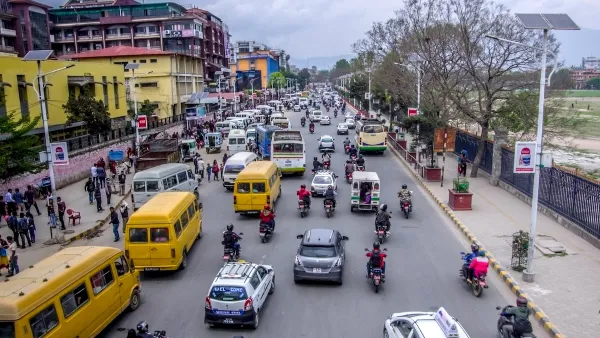Tesla's success with the Model 3 begs the question: When will the trucking industry electrify?

[Updated April 27, 2016]
Anyone who tells you they knew Tesla would presell 400,000 Model 3 cars is lying.
The company's success in terms of design, hardware and software engineering and marketing is remarkable. And while the success of the Model 3 is still in process, because the cars still have to be built and delivered, the wild optimism that Tesla has engendered for nearly a decade seems to more reasonable now than it did when the company had barely sold enough cars to fill the parking lots around AT&T Stadium where the Dallas Cowboys play.*
Now it's time for someone to follow Tesla's lead and bring electrification to the trucking industry. A startup in that sector could learn from the Tesla successes in positioning their brand, the targeting of a small but important piece of a larger market, the capturing of the imagination of the press, and the operational process that brought a technology out of the concept car realm and into the market. The company that can emulate this stands to make a great deal of money and, more importantly, change the way the human race consumes many of its most precious resources.
While personal transport contributes to carbon emissions, in the mind of the average person, it represents a disproportionate amount of the problem. Transportation only accounts for 28 percent of the carbon emitted. Of that 28 percent, personal transport represents a little over half.
Most of the rest comes from trucks. More Americans drive trucks than work at any other profession. When I worked as a purchasing manager at a food company, a big part of my job was arranging transport for the packaging and ingredients we bought. Almost everything was transported via trucks, whether we were receiving corrugated boxes from a warehouse a few miles away or brown rice flower from North Dakota.
Consumer goods cost resources, and more-than-negligible part of this resource cost comes from transporting the goods. It's easier to witness and comprehend the carbon used driving to Best Buy than it is to understand the carbon cost of the computer you buy there or even something more simple to manufacture, such as a Backstreet Boys CD.
There must be a market for trucks with a lower-carbon footprint, especially among companies for which environmentally responsibility is part of their brand position.
Experts disagree about how emissions will be regulated in the future. The Obama Administration had hopes to implement cap and trade, but, in general, environmental regulations tend to become stricter over time. Those who doubt this are probably unaware that the largest U.S. coal producer has shut its doors.
There is a bit engineering problem to solve here. The average 18-wheeler weighs 80,000 pounds when fully loaded. That's considerably more than the weight of the Model X, at 5,441 pounds. That said, this problem is far from insurmountable, BMW has already an electric 18-wheeler on the road in Germany that weighs as much as standard semis in the United States.
An electric option wouldn't immediately get the entire trucking industry off fossil fuels. Not even close. But if a corporation could create a viable option for even a small fraction the industry that could be the starting place for a force that could reshape the entire market. The opportunity is there. In many ways Tesla has already provided the model.
The success of Tesla's consumer vehicles makes a good test case for how the same technology could affect the trucking industry. First a start up would need to create the new option. Dazzle people with the possibility of a new kind of industry. Build from a small but vocal following and lay the groundwork for scale. Media types (like myself) love to cover innovation like this. Prove the concept by serving eco-conscious brands. I know if someone had pitched eco-conscious trucking to the food company for which I did purchasing, we would have given them an audience. Build aggressively on that success to gain the necessary scale, use that scale to push down costs, and use those falling costs to entice the late movers to catch up.
It should be said that brands intent on cutting costs can currently buy carbon offsets, and some do. But that solution doesn't have the same appeal as striking at the root of the problem. Tesla's Innovation grabs attention and headlines. Who will be the Tesla of trucking?
Industrial transport will electrify at some point. The economic and environmental incentives will only get stronger with time. It's not a question of "if," but "when?"
*This is not an exaggeration. If everyone who bought a Tesla in 2013 parked in the parking places provided around the Dallas Cowboy's AT&T Stadium there would be enough parking spaces left for every Cowboy's player to bring his own vehicle, and every member of the coaching staff and an opposing teams players, and their coaching staff and the cheerleaders**.
**This estimate assumes the opposing team would have a comparable number of cheerleaders to the Dallas Cowboys, who employ 36 cheerleaders.
[The post was updated with the proper weights for the Model X and an average 18-wheeler.]

Planetizen Federal Action Tracker
A weekly monitor of how Trump’s orders and actions are impacting planners and planning in America.

Congressman Proposes Bill to Rename DC Metro “Trump Train”
The Make Autorail Great Again Act would withhold federal funding to the system until the Washington Metropolitan Area Transit Authority (WMATA), rebrands as the Washington Metropolitan Authority for Greater Access (WMAGA).

The Simple Legislative Tool Transforming Vacant Downtowns
In California, Michigan and Georgia, an easy win is bringing dollars — and delight — back to city centers.

The States Losing Rural Delivery Rooms at an Alarming Pace
In some states, as few as 9% of rural hospitals still deliver babies. As a result, rising pre-term births, no adequate pre-term care and "harrowing" close calls are a growing reality.

The Small South Asian Republic Going all in on EVs
Thanks to one simple policy change less than five years ago, 65% of new cars in this Himalayan country are now electric.

DC Backpedals on Bike Lane Protection, Swaps Barriers for Paint
Citing aesthetic concerns, the city is removing the concrete barriers and flexposts that once separated Arizona Avenue cyclists from motor vehicles.
Urban Design for Planners 1: Software Tools
This six-course series explores essential urban design concepts using open source software and equips planners with the tools they need to participate fully in the urban design process.
Planning for Universal Design
Learn the tools for implementing Universal Design in planning regulations.
Smith Gee Studio
City of Charlotte
City of Camden Redevelopment Agency
City of Astoria
Transportation Research & Education Center (TREC) at Portland State University
US High Speed Rail Association
City of Camden Redevelopment Agency
Municipality of Princeton (NJ)





























